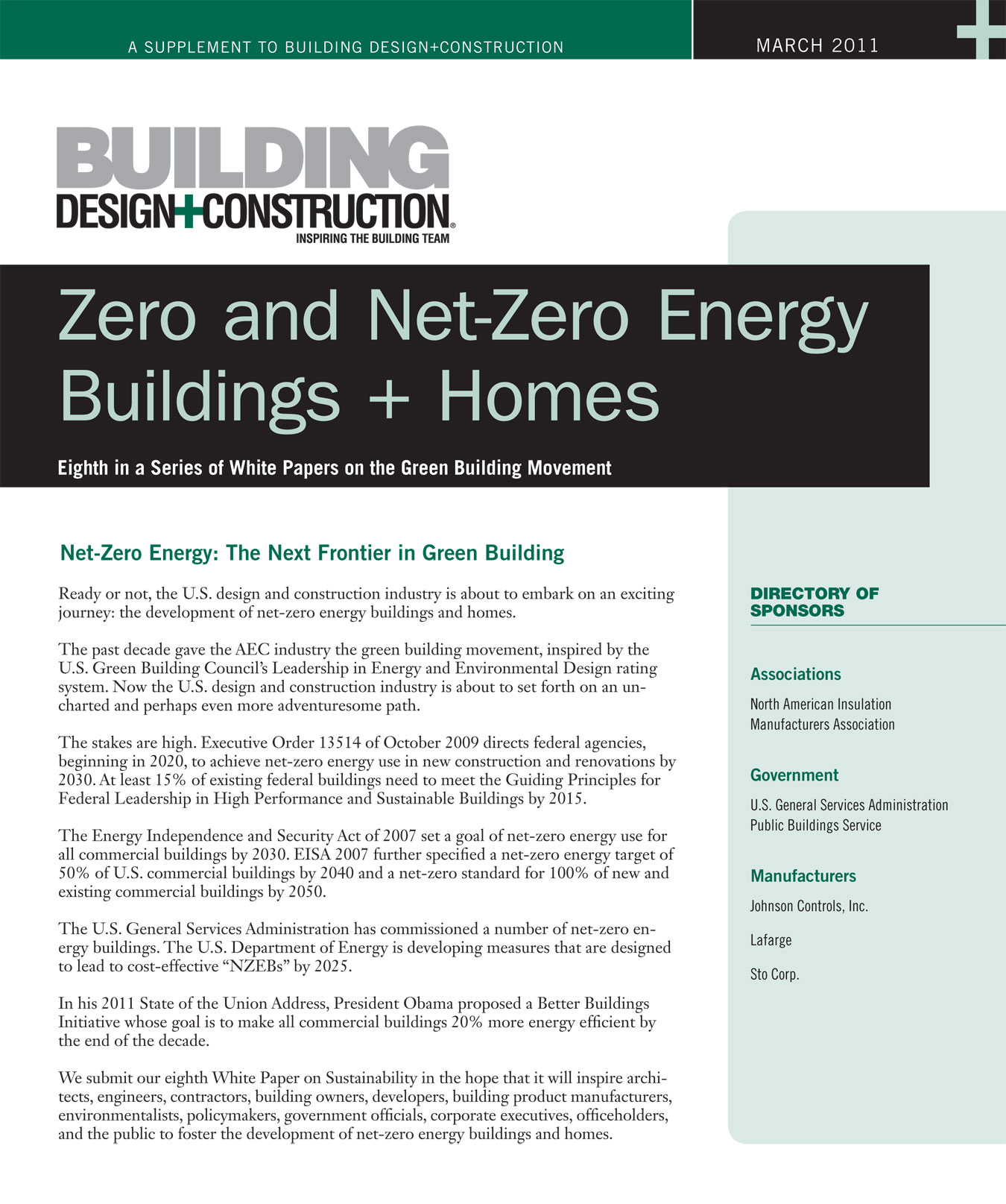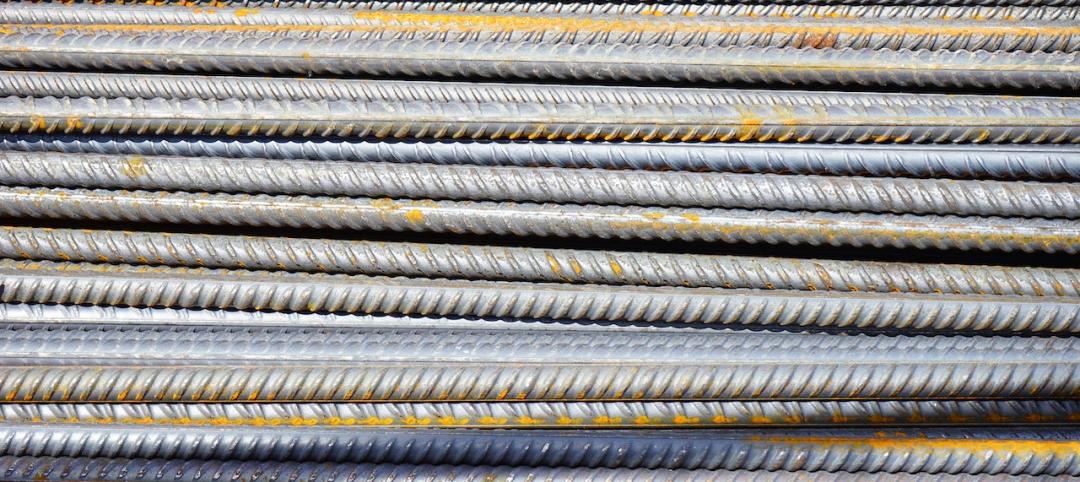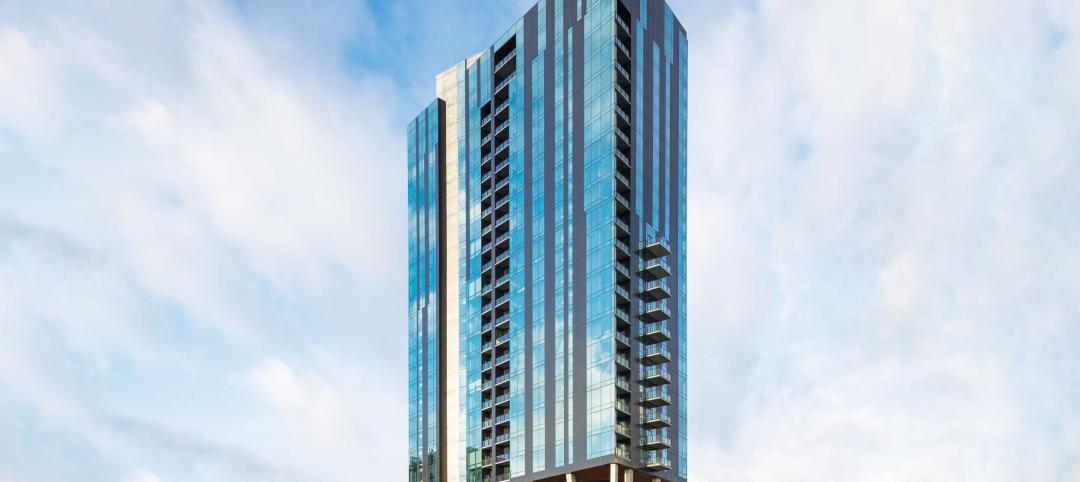“Zero and Net-zero Energy Buildings + Homes,” a 64-page White Paper that proclaims “the next frontier in the green building movement,” will be the topic of a 1-hr Q&A with 6 “NZEB” experts at the AIA Conference + Expo, Friday, May 13, 11 a.m. to 12 noon, at the Morial Convention Center (Level 2, Room R06), New Orleans.
The 40,000-word report from Building Design+Construction provides a road map for the $350 billion design, construction, and real estate industry to develop “net-zero” buildings and homes that generate as much energy as they use, such as the new Research Support Facility at the National Renewable Energy Laboratory, in Golden, Colo.
Robert Cassidy, BD+C’s editorial director, will moderate the discussion with the panel:
- Paul Torcellini, PE, PhD – U.S. Dept of Energy and National Renewable Energy Lab
- Tom Hootman, AIA, LEED AP – RNL Design (Research Support Facility design team)
- Philip Macey, AIA, LEED AP – Haselden Construction (Research Support Facility construction manager)
- Marc L’Italien, FAIA, LEED AP – EHDD Architecture (Exploratorium, Packard Foundation, and several other net-zero energy projects)
- Mary Ann Lazarus, FAIA, LEED AP – HOK (net-zero carbon prototype)
- David Eijadi, FAIA, LEED AP BD+C – The Weidt Group (environmental building consultant for Science House/Science Museum of Minn., net-zero carbon prototype)
Potential topics of discussion (questions from media representatives are welcome!):
- What did the experts learn from their NZEB experiences? What advice do they have for future NZEB designers, contractors, and building owners/developers?
- How do you measure and monitor the actual performance of NZEBs?
- What’s the “business case” for NZEBs? Do they make financial sense for owners?
- Is there a gulf between what the energy model predicts and actual outcome?
- What are the impediments – technical and otherwise – to producing NZEBs?
- What about net-zero energy (and net-zero carbon) for existing buildings?
The White Paper, along with seven previous reports devoted to green building, is available for free download at www.BDCnetwork.com/whitepapers.
The report was sponsored by Johnson Controls, Lafarge, North American Insulation Manufacturers Association, Sto Corp., and the U.S. General Services Administration.
Contact: Robert Cassidy, BD+C Editorial Director, rcassidy@sgcmail.com, 847-391-1040 office; 773-220-3555 mobile – Booth 142 at AIA
Related Stories
Adaptive Reuse | Jul 6, 2023
The responsibility of adapting historic university buildings
Shepley Bulfinch's David Whitehill, AIA, believes the adaptive reuse of historic university buildings is not a matter of sentimentality but of practicality, progress, and preservation.
Apartments | Jun 27, 2023
Dallas high-rise multifamily tower is first in state to receive WELL Gold certification
HALL Arts Residences, 28-story luxury residential high-rise in the Dallas Arts District, recently became the first high-rise multifamily tower in Texas to receive WELL Gold Certification, a designation issued by the International WELL Building Institute. The HKS-designed condominium tower was designed with numerous wellness details.
Building Materials | Jun 14, 2023
Construction input prices fall 0.6% in May 2023
Construction input prices fell 0.6% in May compared to the previous month, according to an Associated Builders and Contractors analysis of the U.S. Bureau of Labor Statistics’ Producer Price Index data released today. Nonresidential construction input prices declined 0.5% for the month.
Sustainability | Apr 20, 2023
13 trends, technologies, and strategies to expect in 2023
Biophilic design, microgrids, and decarbonization—these are three of the trends, technologies, and strategies IMEG’s market and service leaders believe are poised to have a growing impact on the built environment.
Codes | Mar 2, 2023
Biden Administration’s proposed building materials rules increase domestic requirements
The Biden Administration’s proposal on building materials rules used on federal construction and federally funded state and local buildings would significantly boost the made-in-America mandate. In the past, products could qualify as domestically made if at least 55% of the value of their components were from the U.S.
AEC Innovators | Feb 28, 2023
Meet the 'urban miner' who is rethinking how we deconstruct and reuse buildings
New Horizon Urban Mining, a demolition firm in the Netherlands, has hitched its business model to construction materials recycling. It's plan: deconstruct buildings and infrastructure and sell the building products for reuse in new construction. New Horizon and its Founder Michel Baars have been named 2023 AEC Innovators by Building Design+Construction editors.
Sustainability | Feb 8, 2023
A wind energy system—without the blades—can be placed on commercial building rooftops
Aeromine Technologies’ bladeless system captures and amplifies a building’s airflow like airfoils on a race car.
Mass Timber | Jan 27, 2023
How to set up your next mass timber construction project for success
XL Construction co-founder Dave Beck shares important preconstruction steps for designing and building mass timber buildings.
Products and Materials | Jan 18, 2023
6 innovative products for multifamily developments
Here are six innovative products for various multifamily developments, including a condominium-wide smart electrical system, heavy-duty aluminum doors, and prefabricated panels.
Green | Dec 9, 2022
Reaching carbon neutrality in building portfolios ranks high for organizations
Reaching carbon neutrality with their building portfolios ranks high in importance among sustainability goals for organizations responding to a Honeywell/Reuters survey of senior executives at 187 large, multinational corporations. Nearly nine in 10 respondents (87%) say that achieving carbon neutrality in their building portfolio is either extremely (58%) or somewhat (29%) important in relation to their overall ESG goals. Only 4% of respondents called it unimportant.

















